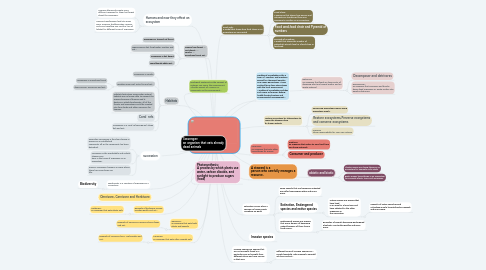Ecosystems
por Isabella Di Vetta


1. Example of herbivore mouse, monkey,gorilla and est...
1.1. Herbivore: an organism that eats plants only
2. Omnivore, Carnivore and Herbivore
3. Humans and now they effect an ecosystem
3.1. Humans afterwards create many different recesses for them but forget about the organisms.
3.2. Humans transforming land into many ways. Farming, building cities, mining, and even travelling can result in loss of habitat for different types of organisms.
4. Biodiversity is a variation of organisms in a ecosystem.
4.1. Biodiversity
5. Tropical rain forest. ... Hot desert. ... Tundra. ... Deciduous forest est...
5.1. Organisms in tropical rail forest
5.2. jaguar,poison dart frog,howler monkey and est...
5.3. Organisms in hot desert
5.4. camel,lizards,addax est...
6. Carnivore: an organism that eats other animals only
6.1. Example of carnivore lions . owls,eagles and est..
7. Ecological Footprints is the amount of restores you use in the environment. Also,the impact of a person or community on the environment, .
8. Habitats
8.1. Organisms in Tundra
8.2. reindeer,snow owl, arctic fox and est...
8.2.1. Organisms in Deciduous forest
8.2.2. deer,raccoon, opossums and est..
8.3. Habitat destruction occurs when natural habitats are no longer able to support the species because of humans and it destroys a whole biodiversity, all of the forests and ecosystems could be created into farm lands and other resources for humans.
8.4. Coral refs
8.5. Organisms in a coral ref sponge,eel ,clown fish and est..
9. Photosynthesis: A process by which plants use water, carbon dioxide, and sunlight to produce sugars (food)
10. Scavenger: an organism that eats already dead animals
11. Omnivore: an organism that eats both plants and animals
11.1. Example of omnivores raccoons,bears,foxes and est..
12. succession
12.1. Secondary succession is the slow change in species in an established community aft er the community has been disturbed.
12.2. succession is the predictable and orderly change over time in the types of organisms in an ecosystem.
12.3. Primary succession happens in areas where there has never been any life.
13. Invasive species
14. restore ecosystems by taking steps to repair the damage done by human activity.
14.1. Conserving ecosystems means using ecosystems wisely.
14.2. Restore ecosystems,Perverse ecosystems and conserve ecosystems
14.3. Preserve taking responsibility for your own actions.
15. Food Web: a model that shows how food chains in an ecosystem are connected
15.1. Food Chain: a sequence that shows how energy and nutrients are transferred from one organism to another in an ecosystem
15.2. Food wed,food chain and Pyramid of numbers
15.3. Pyramid Of Numbers: a model that shows the number of individuals at each level in a food chain or food web
16. Detrivore: an organism that feeds on large parts of decaying plant and animal matter and on waste material
16.1. Decomposer and detrivores
16.2. Decomposer: an organism that consumes and breaks down dead organisms or waste matter into simple substances
17. Traditional Knowledge is the a term of , wisdom, and practices gained by Aboriginal peoples over many generations. It was evolved form close interactions with the local environment. "Traditional Knowledge includes such areas as farming, fishing, health,forestry,hunting and environmental management."
18. Consumer: an organism that eats other living things for energy
18.1. Producer: an organism that makes its own food from non-living materials
18.2. Consumer and producer
19. Extinction occurs when a species no longer exists anywhere on Earth
19.1. Some animals that are becoming extincted are pallor bears,jaguar,zebra and many more.
19.2. Extinction, Endangered species and native species
19.2.1. Native species are species that have lived in an area for a long time and have adapted to the other organisms in the ecosystem.
19.2.1.1. example of native speeches Red columbine,purple loosetrife,zebra mussels and many more.
19.3. Endangered species are species that are in danger of becoming extinct,because of there lose in food source.
19.3.1. Examples of animals becoming Endangered elephants ,sea turtles,gorillas and many more.

